2017 Ultra Classic Harley
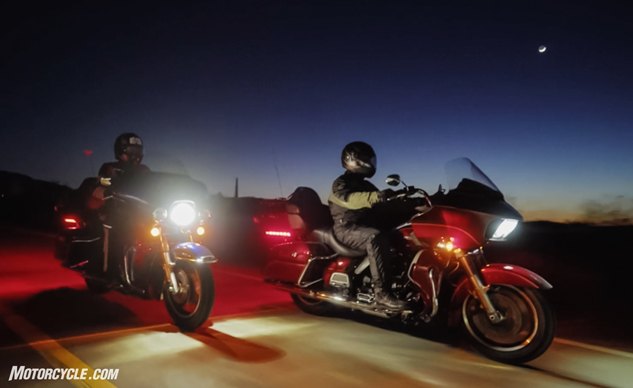
- Go Back
Video by: James Martinec
Typically, when we perform a comparison test, we select bikes in the same category to see which one works best. This time, however, we're approaching this comparison with a few long-lingering questions in mind: How does having a fork-mounted fairing or a frame-mounted fairing affect the dynamics of a motorcycle? Does having the weight of the fairing on the fork make it floppy at low speeds? Do fork-mounted fairings interact with prevailing wind or turbulence coming off of vehicles? How noticeable is the improved wind protection on the frame-mounted fairing – particularly during cold-weather riding?
Get the Flash Player to see this player.
While we initially envisioned this comparison including the Street Glide (America's most popular street bike) to accomplish this task, we selected the Harley-Davidson Electra Glide Ultra Classic and the Harley-Davidson Road Glide Ultra because they both have trunks, making these bikes as close to identical as possible. Our operating theory is that this will enable us to better understand the differences between these otherwise similar bikes. Take a look at the spec sheet. The variances – other than the fairings – are few and far between. For example, the chassis-geometry numbers are virtually identical.
2017 Harley-Davidson Ultra Limited First Ride Review
2016 Harley-Davidson Road Glide Ultra – First Ride Review
American Iron Butt: Conquering A SaddleSore 1000
To test our theory, we set our sights on completing an Iron Butt Association SaddleSore 1000 – or, in layman's terms, ride 1,000 miles in less than 24 hours. We figured that swapping bikes at every gas stop would give us ample time to suss out any differences between the two bikes. In the end, while there were some differences, what was remarkable about these two bikes was that the differences were so minimal. Another key distinction is the Milwaukee-Eight powerplants: The Road Glide is blessed with the liquid-cooled heads and dual radiators of the Twin-Cooled Milwaukee-Eight, while the Electra Glide uses the air-cooled version.
We deliberately chose two bikes that were as close to identical as possible so that we could track the difference between fork-mounted and frame-mounted fairings.
More Than Fraternal Twins
Starting from the inside and working our way out, our two contestants share the same frame with the same 26° rake and 6.7 in. trail. The 49mm conventional fork and the new dual emulsion-style shocks, which feature hydraulically adjustable preload on left shock only, handle suspension duties and were fit to the entire touring line in 2017. The wheels are the same Impeller Cast Aluminum units of the 17-inch front and 16-inch rear variety. Once the rolling gear is attached, the result is a 64.0-inch wheelbase. For some reason, Harley lists their seat heights at 29.1 in. for the Electra Glide and 29.0 in. for the Road Glide, even though they are visually (and buttocks-confirmed) identical.
2017 Harley-Davidson Milwaukee-Eight Engines Tech Brief
In the engine bay, rubber-mounted Milwaukee-Eights provide the thrust – as they do with all 2017 touring models. According to Harley's claimed output numbers, the Twin-Cooled Eight should put out slightly more torque, but our trip to the dyno revealed that the roles were reversed. On the MotoGP Werks dyno that serves as the standard for all our tests, the Electra Glide's peak of 78.4 hp was 4.6 hp higher than the Road Glide in addition to tracking consistently higher throughout the rpm range.
When we asked Harley about this surprising difference in power, we received the following response:
- Although both versions of the Milwaukee-Eight engine share the share compression ratio and other mechanical specs, we have reported a 2% difference in torque between the two configurations for certification purposes (with Twin-Cooled version being higher) due to the more precise knock control offered by the water-cooled heads. However, there can also be a couple of percent difference in results even in our own certified test cells, in addition to variances engine to engine. So in other words, you could see a combination of an air-cooled engine on the high end of the spectrum and water-cooled engine on the lower end, or vice versa.
- Dyno testing procedures are critical when testing either engine. Both oil and water temperature need to be precisely controlled. Specifically, if the water-cooled head is not warmed to optimal operating temperature, there will be less than optimal spark control, which could be affecting its power output more than the air-cooled version.
- Finally, we're confident that under real-world operating conditions, most customers will notice much more consistent performance over longer distances and hotter operating conditions with the Twin-Cooled version of the Milwaukee-Eight, which we consider to be its primary advantage.
We believe that the first note was the culprit, since both bikes were ridden for approximately 45 minutes to the dyno location and immediately loaded on the dyno and tested. So, they would have been at full operating temperature. Our experience of the two engines from the saddle was that the character of the power delivery was so similar, making the difference in power barely noticeable. In fact, we had chalked up the Electra Glide's slight performance edge to the 25 lb. less that it weighs compared to the Road Glide.
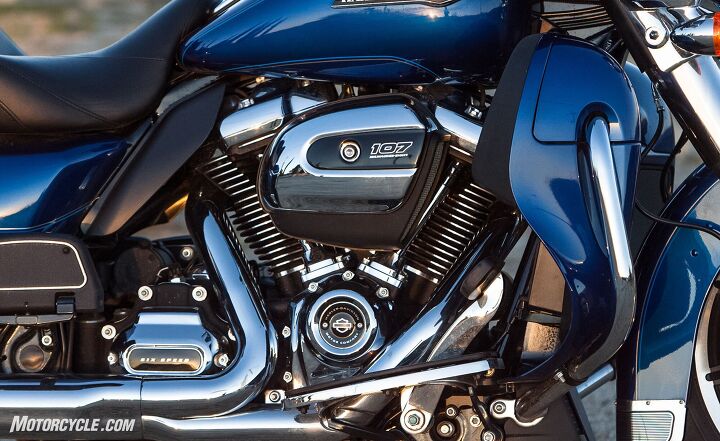
The Electra Glide's Milwaukee-Eight engine surprisingly put out 4.6 more hp than the Road Glide's Twin-Cooled Milwaukee-Eight.
When it comes to the engine character, Fully-Electrified Editor, Tom Roderick, had praise for the Milwaukee-Eight. He loved how it "thrummed along at freeway speeds sounding like a propeller-driven airplane," although it still required a "downshift from 6th to 5th for expedient passing power or when climbing a significant grade." The overall impression of the Milwaukee-Eight engine is that of a more refined, slightly more powerful package. However, it isn't a perfect engine. Despite the inclusion of a torque-assist clutch which requires 7% less effort, Tom opined that the new clutch still "feels like I'm slowly ratcheting up a boat anchor from the bottom of the sea with each squeeze of the lever."
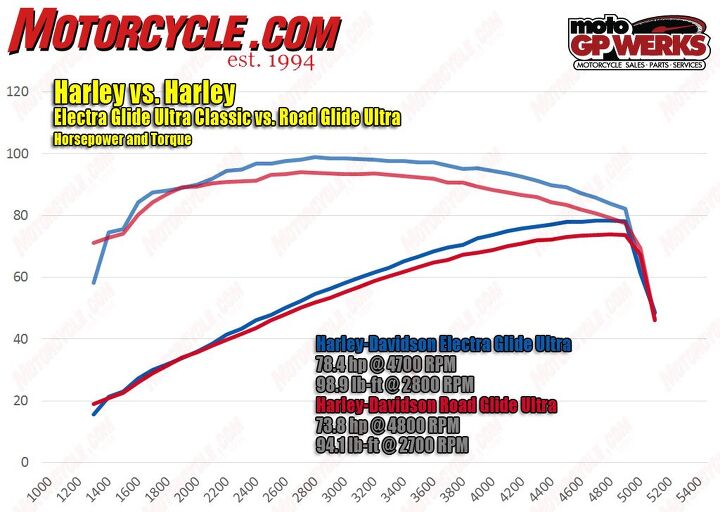
Although Harley says the Twin-Cooled Milwaukee-Eight should perform slightly better, the Electra Glide's air-cooled Milwaukee-Eight outperformed the Road Glide's Twin-Cooled engine throughout the rpm range.
Storage volume is a whopping 35 gallons for both bikes, with the trunk being capable of swallowing a pair of full-face helmets. The only difference being the small storage space in the Road Glide's fairing, a location that we found to be quite useful. The Electra Glide's fairing storage consisted of a small compartment (complete with USB power) for cell phones. However, this space is quite small and couldn't accommodate my iPhone 6 with its case installed.
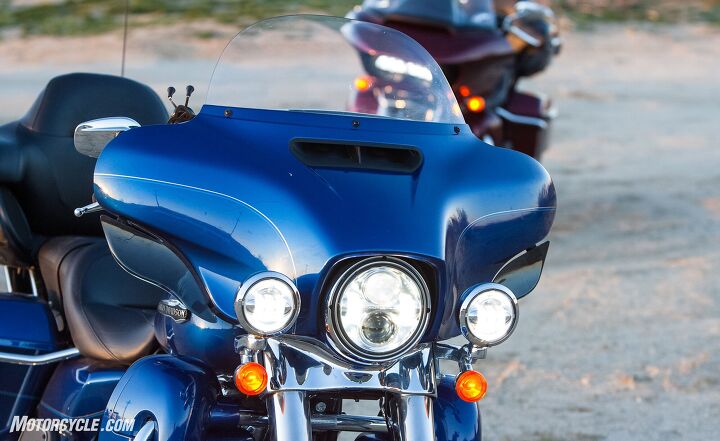
The Electra Glide's fork-mounted fairing doesn't offer as much weather protection as the Road Glide, due mostly to the space between the fairing and the chassis.
A Pair Of Fairings
So, this brings us to weather protection. The frame-mounted fairing of the Road Glide offers the most weather protection, making it considerably warmer when the temperatures dropped to the mid-30s on our overnight ride. The pocket of relatively still air envelops the rider's body while the airflow is deflected largely above the rider's head with a minimum of buffeting at elevated speeds. In warmer temperatures, opening the two vents in the fairing's snout flows a surprisingly large amount of air from either side of the dual headlights over the triple clamp to the rider's torso.
The Electra Glide's fairing offers some control of airflow in the form of winglets on the base of the fork-mounted batwing fairing. In warmer weather, the winglets rotate to direct more cooling air at the rider. However, a fair amount of wind makes it past them to the rider's lower torso when they are in their deployed position. During the cold hours of the night, this was especially noticeable. The airflow around the rider's head had minimal turbulence, regardless of the speed. Tom noted, "I like the height of the Electra Glide's windscreen. It's low enough that it doesn't cross directly through my field of vision like the taller windscreen on the Road Glide. In terms of buffeting, I didn't feel a noticeable difference riding behind either windscreen."
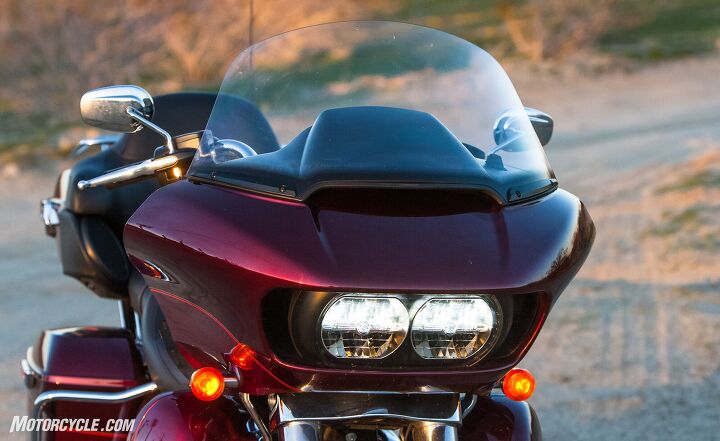
The Road Glide's fairing felt much further away from the rider, and the windshield's height placed it in the rider's field of vision. The vents on either side of the headlights flow a prodigious amount of air when opened.
Several sections of road during our SaddleSore 1000 had us battling heavy crosswinds, which brought to light a difference between the bikes. In these situations, the Road Glide remained rock steady as it leaned into the onslaught. The Electra Glide, however, battled with the crosswinds a bit. It wasn't dangerous, but the fairing's interaction with the wind created steering inputs via its fork mount. These were easily addressed, requiring only a little of extra attention to maintain a steady path.
One component of the Electra Glide's fairing literally outshone the Road Glide's is the Daymaker headlight. Despite the fact that the Road Glide has two LED headlights, its high beams were relatively flaccid in the total darkness of the desert night. The Daymaker could overpower the Road Glide's headlights from behind when both were running their high beams.
"The Daymaker headlight on the Electra Glide is incredible," Tom enthused, "Side-by-side going down the highway the Electra Glide Daymaker headlight is so powerful you'd never know the Road Glide had its headlights illuminated." The Electra Glide's auxiliary lights illuminate a large portion of the road when the Daymaker is on its low beam, however we noticed that, on two-lane rural highways, we were frequently flashed by oncoming traffic. Turning the auxiliary lights off stopped the flashes.
Electronics Abound
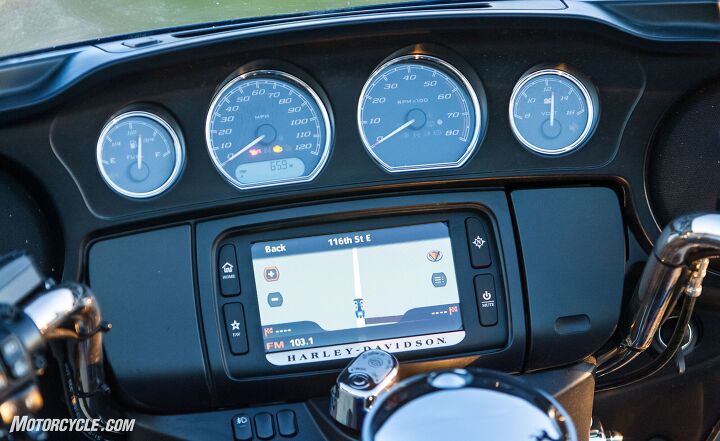
Though the Electra Glide's touchscreen is physically smaller, it seemed bigger because of its relative closeness to the rider. Both Tom and I preferred the location of the speedometer/tachometer high in the fairing versus down on the triple clamp like the Road Glide.
Both the Electra Glide and the Road Glide offer the amenities that you'd expect from a touring rig – with one notable exception. Both feature excellent cruise controls that can be adjusted up and down in one mile-per-hour increments. Nothing makes logging long hours in the saddle easier than being able to set the speed and relax the throttle hand.
The other area where both of these bikes provided top-notch touring amenities was the infotainment systems. The Electra Glide sports the Boom! Box with its 4.3-inch screen, while the Road Glide gets the larger 6.6-inch version. Ironically, although the Road Glide has the larger screen, its further distance from the rider makes it appear visually smaller. The reach to the screen on the Electra Glide was also much more manageable for us 5-foot 11-inch types. We've been told by Harley representatives that many of the Road Glide's owners are on the far side of six feet, perhaps making this extra reach a non-issue for many riders. Regardless of the screen size, both stereos pumped out enough volume to be heard relatively clearly at high speeds. In fact, Tom's music was so loud that it often triggered the VOX function on his communicator. So, I spent much of the ride listening to Tom's music on my headphones.
"Both bikes have incredible sound systems," Tom observed. "Riding at a steady 80 mph and being able to clearly hear what's being said on talk radio while wearing a full-face helmet is testament to how good the systems are. But, listening to some loud classic rock is when the Boom stereo system is at its best."
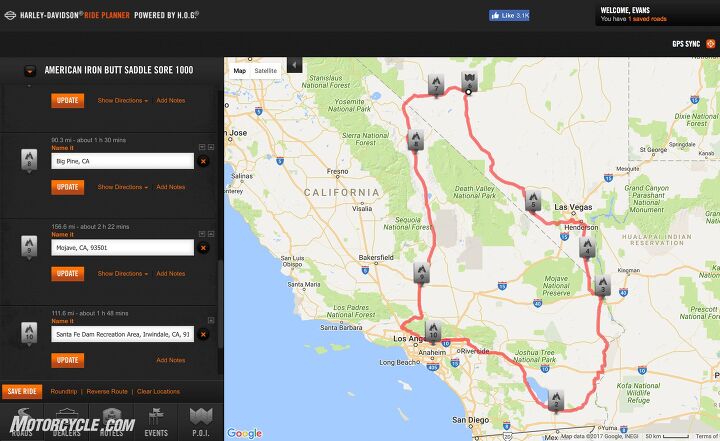
The Harley Ride Planner makes it possible to create routes on your home computer and transfer them to the onboard GPS for worry-free travel.
The GPS on both bikes benefit from the ability to create a route through Harley's online Ride Planner service and then transfer it via USB thumb drive to the bike itself. This made sure that we didn't take any wrong turns as our SaddleSore wore on. The benefit of being able to plan a long, complicated route on a computer rather than the small touchscreen can't be overstated. I was able to create a couple variations on our route prior to selecting and loading the final version onto the bikes. Once underway, the directions were consistently accurate, a fact we verified by running a GPS app on a smartphone throughout the ride. Occasionally the phone and the bike would disagree on the quickest way to get through an urban location, but we chalked that up to the phone having access to traffic data.
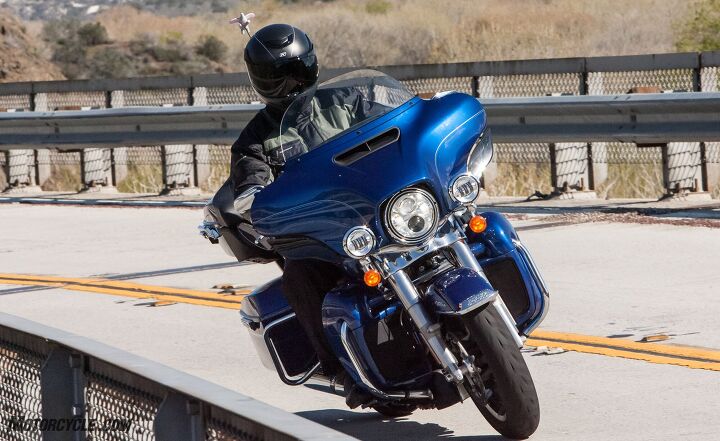
Travel In Comfort
When racking up the miles, both the Electra Glide and the Road Glide were remarkably comfortable as the hours ticked past. From the waist down, the two hold the rider in exactly the same position. (If you haven't studied the animated GIF already, take a moment to look at how the seats and the floorboards are identically placed.) The seats themselves are just about perfect. Even with our roughly 200-mile stints, then fuel, switch bikes, and repeat cycle, neither of us experienced any derrière distress. The padding is the right soft-to-firm ratio and wide enough to allow wiggle room to maintain comfort.
From the waist up, however, the riding positions are markedly different. The Electra Glide's handlebar is lower and closer to the rider. The bar's width gives enough leverage to maneuver the bike without spreading the rider's arms overly wide. This pays off in long-term comfort and during U-turns or tight parking lot maneuvers. The Electra Glide rider has a relatively neutral with just a slight forward lean.

The Road Glide's higher grip location distanced the rider from the front tire's feeling.
In contrast, the Road Glide's grips are significantly higher and slightly more rearward, resulting in a more upright riding position that rocks a pelvis slightly rearward and causing me some lower-back strain during long stints. Tom noticed that the "higher bars of the Road Glide angle my wrists in a way that makes manipulating the controls more difficult." This causes a long reach to the grip during tight turns which can make controlling the throttle a challenge.
Additionally, I felt more removed from what was happening at the front contact patch. The effect is that of steering with a tiller versus having a direct connection to the road. The result of the different handlebars is that the Electra Glide feels more responsive to steering inputs. With the exception of feeling removed from the contact patch, all of these gripes about the Road Glide are from a 5-foot 11-inch perspective, and taller riders might not experience the riding position the same way.
Since we're discussing rider comfort, now seems like the appropriate time to question why Harley would sell such well-appointed touring bikes without heated grips (although they are available as a factory accessory). While this seems like such a small complaint, it grows in size when the ambient temperature drops below 50° F. When it reaches the mid-30s, the oversight becomes more than just a puzzler you mull over as your fingers begin to tingle.
Examining The Results
We set out on this comparison with some specific theories to test. Throughout the ride, we discussed how identically these two touring rigs behaved. We expected some handling differences, but the only one that could be attributed to the fairing mount (and not the handlebar/grip placement) was the way the Electra Glide interacted with cross-winds. When considering how the wind could interact with the fairing shape of either bike and direct the forces generated into the fairing's mounts, it makes sense that these forces would create steering inputs on the fork-mounted fairing.
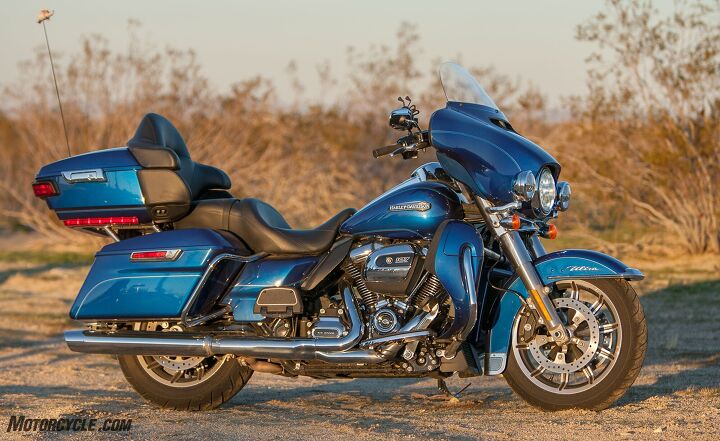
However, the area of difference that was most noticeable between the two bikes was the steering feel, and this we attributed to the location of the grips on the two bikes and the leverage we had on them. In this category, the Electra Glide felt sporty in comparison to the Road Glide. When we were on winding sections of road, the Electra Glide was more responsive and, consequently, more fun to ride – though both bikes more than handled every riding situation we tossed at them over our 24-hour ride and in the weeks afterwards.
Although we undertook this comparison out of curiosity and not a desire to say which bike wins, we do have the MO Scorecard, and therefore, we used it. However, before we reveal the results, consider this: If you're a touring rider who values weather protection over everything else, the Road Glide will be your best bet. If you're an average-sized person who prefers responsive steering or likes to fiddle with the GPS and other touchscreen items on the road, you'll find a happy home on the Electra Glide.

According to the famed MO Scorecard, the Harley-Davidson Electra Glide Ultra Classic wins with a score of 89.14% against the Road Glide Ultra's 87.31%. The Road Glide's $2,850 premium over the Electra Glide's $24,749 price puts it into a scoring hole it was unable to crawl out of. Consequently, the final score was the result of the price difference and the little niggles (such as riding position and handling) mentioned in this article.
If you're looking for a bike to ride a SaddleSore 1000 – or more – you won't go wrong with either of these bikes. If you like to let the Great American Road roll out in front of you for days at a time, you'll find yourself happy with either of these choices.
| Harley-Davidson Fairing Comparison Scorecard | ||||
|---|---|---|---|---|
| 2017 H-D Electra Glide Ultra Classic | 2017 H-D Road Glide Ultra | |||
| Price | 100% | 89.7% | ||
| Weight | 100% | 97.3% | ||
| lb/hp | 100% | 92.1% | ||
| lb/lb-ft | 100% | 92.9% | ||
| Total Objective Scores | 100% | 93.2% | ||
| Engine | 91.3% | 91.3% | ||
| Transmission/Clutch | 85.0% | 85.0% | ||
| Handling | 83.8% | 82.5% | ||
| Brakes | 86.3% | 86.3% | ||
| Suspension | 83.75% | 85.0% | ||
| Technologies | 82.5% | 82.5% | ||
| Instruments | 82.50% | 81.3% | ||
| Ergonomics/Comfort | 87.5% | 91.3% | ||
| Luggage/Storage | 90.0% | 90.0% | ||
| Quality, Fit & Finish | 92.5% | 92.5% | ||
| Cool Factor | 82.5% | 85.0% | ||
| Grin Factor | 80.0% | 81.3% | ||
| Evans' Subjective Scores | 87.7% | 86.4% | ||
| Tom's Subjective Scores | 85.6% | 85.6% | ||
| Overall Score | 89.1% | 87.3% | ||
| Harley-Davidson Fairing Comparison Specifications | ||||
|---|---|---|---|---|
| 2017 H-D Electra Glide Ultra Classic | 2017 H-D Road Glide Ultra | |||
| MSRP | $24,749 | $27,599 | ||
| Engine Type | Air-cooled, Milwaukee-Eight 107 45° V-Twin | Twin-cooled, Milwaukee-Eight 107 45° V-Twin | ||
| Bore and Stroke | 101.6mm x 114.3mm | 101.6mm x 114.3mm | ||
| Fuel System | Electronic Sequential Port Fuel Injection (ESPFI) | Electronic Sequential Port Fuel Injection (ESPFI) | ||
| Ignition | Electronic | Electronic | ||
| Compression Ratio | 10.0:1 | 10.0:1 | ||
| Peak hp | 78.4 hp | 73.8 hp | ||
| Peak Torque | 98.9 lb-ft | 94.1 lb-ft | ||
| Transmission | 6-speed | 6-speed | ||
| Final Drive | Belt | Belt | ||
| Front Suspension | 49mm conventional fork | 49mm conventional fork | ||
| Rear Suspension | Dual emulsion-style shocks, hydraulically adjustable preload on left shock. | Dual emulsion-style shocks, hydraulically adjustable preload on left shock. | ||
| Front Brake | Dual 320mm, four-piston calipers | Dual 320mm, four-piston calipers | ||
| Rear Brake | 320mm, four-piston caliper | 320mm, four-piston caliper | ||
| Front Tire | BW 130/80B17 65H | BW 130/80B17 65H | ||
| Rear Tire | BW 180/65B16 81H | BW 180/65B16 81H | ||
| Rake/Trail | 26° / 6.7 in. | 26° / 6.7 in. | ||
| Wheelbase | 64.0 in. | 64.0 in. | ||
| Seat Height | 29.1 | 29 | ||
| Measured Weight | 906 lb. | 931 lb. | ||
| Fuel Capacity | 6 gallons | 6 gallons | ||
| Available Colors | Mysterious Red Sunglo/Velocity Red Sunglo Billet Silver/Vivid Black Crushed Ice Pearl/Frosted Teal Pearl Billet Silver Superior Blue Vivid Black | Vivid Black Black Quartz Mysterious Red Sunglo/Velocity Red Sunglo Billet Silver/Vivid Black Black Hills Gold/Black Quartz Bonneville Blue/Fathom Blue | ||
| Warranty | 24 months | 24 months | ||
Source: https://www.motorcycle.com/shoot-outs/2017-harley-davidson-electra-glide-ultra-classic-vs-road-glide-ultra
